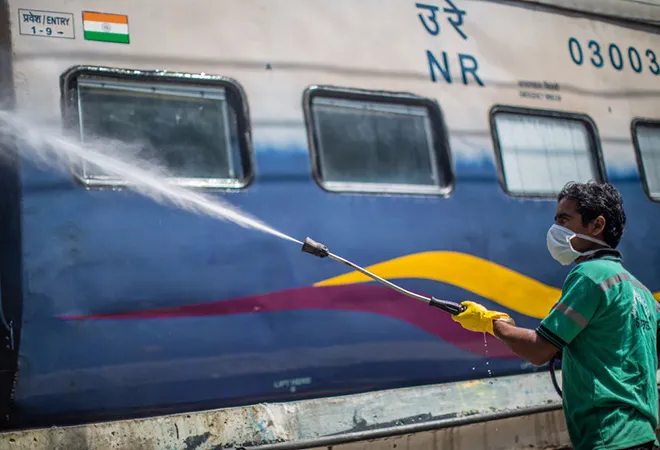-
CENTRES
Progammes & Centres
Location
Having an urban welfare strategy in place would have allowed the government to act immediately to support workers affected by the coronavirus shock. Unfortunately, none of these protections have been put in place so far.
 The economic impacts of the coronavirus pandemic are just coming to light, with supply chain disruptions, crashing financial markets and slowing demand. The OECD has cut its forecast for global growth in 2020 to 2.4% (from 2.9% earlier), warning that if the pandemic spreads globally this could fall further to 1.5%. Bloomberg estimates that the virus could cost the global economy $2.7 tn in lost output, equivalent to India’s GDP.
While novel coronavirus has not infected much of the Indian population yet, a number of measures have been implemented across Indian cities to prevent its spread. These include remote working policies in the corporate sector, school closures, shutting down malls, restaurants, gyms and cinemas, and the cancellation of big events. Travel restrictions have reduced the flow of tourists, with foreign and domestic tourist arrivals down by 67% and 40%, respectively, in the January-March quarter.
Across the world, such social distancing and travel restrictions have impacted economic activity, and, according to a World Economic Forum survey of leading economists, this is likely to lead to a global recession. This is already being seen in China, where the crisis originated, and strict lockdowns have been in place for a couple of months. In January-February 2020, fixed investments contracted 24.5%, retail sales fell 20.5% and industrial output fell 13.5%. Estimates by Dan Wang of the Economist Intelligence Unit suggest that the epidemic could lead to 9 million people in China’s cities losing their jobs over the year, and workers seeing wages cut by 30-50%.
Most countries which have implemented social distancing are also putting in place policies to protect the livelihoods of workers, as well support small businesses. These policies include:
The economic impacts of the coronavirus pandemic are just coming to light, with supply chain disruptions, crashing financial markets and slowing demand. The OECD has cut its forecast for global growth in 2020 to 2.4% (from 2.9% earlier), warning that if the pandemic spreads globally this could fall further to 1.5%. Bloomberg estimates that the virus could cost the global economy $2.7 tn in lost output, equivalent to India’s GDP.
While novel coronavirus has not infected much of the Indian population yet, a number of measures have been implemented across Indian cities to prevent its spread. These include remote working policies in the corporate sector, school closures, shutting down malls, restaurants, gyms and cinemas, and the cancellation of big events. Travel restrictions have reduced the flow of tourists, with foreign and domestic tourist arrivals down by 67% and 40%, respectively, in the January-March quarter.
Across the world, such social distancing and travel restrictions have impacted economic activity, and, according to a World Economic Forum survey of leading economists, this is likely to lead to a global recession. This is already being seen in China, where the crisis originated, and strict lockdowns have been in place for a couple of months. In January-February 2020, fixed investments contracted 24.5%, retail sales fell 20.5% and industrial output fell 13.5%. Estimates by Dan Wang of the Economist Intelligence Unit suggest that the epidemic could lead to 9 million people in China’s cities losing their jobs over the year, and workers seeing wages cut by 30-50%.
Most countries which have implemented social distancing are also putting in place policies to protect the livelihoods of workers, as well support small businesses. These policies include:
i. Wage subsidies for people who have taken leave to care for children due to schools being closed (France, Japan and Korea) <1>
ii. Cash transfers for vulnerable groups (China and Italy)
iii. Tax relief for people and business (China, Korea, Italy, Germany, Vietnam, US and Iran) <2>, and
iv. Subsidies to firms providing paid sick leave (UK). <3> This allows for a temporary source of cash flow to people and firms which are affected, and can be removed once the emergency abates.
In India, however, the large numbers of informal workers will make such targeted policies impossible to achieve. The latest Periodic Labour Force Survey (2017-18) found that only 47% of urban workers have regular, salaried jobs. Even among workers in formal employment, over 70% do not have contracts, 54% are not entitled to paid sick leave and 49% are do not have any form of social security benefits. The remaining 53%, who work in the informal sector, have even less access to social protection. These workers: taxi drivers, road-side vendors, owners of small businesses, tourist guides, restaurant workers etc., will be the worst hit as demand for their services falls. They also do not have the means to remain in quarantine or take the day off if they are ill. India has made huge strides in poverty alleviation, and has also put in place social safety nets for the poor which guarantee access to employment (MNREGA), nutrition (PDS), health services (PM-JAY) and even a basic income (PM-KISAN). These schemes, however, largely target the rural poor, and are focused on ensuring they are able to subsist. They ignore the rapidly growing urban population (at around 2.3% annually), which in 2018 accounted for about 34% of the population. <4> Data from the World Bank shows that the poverty rate is 14% in urban India, and even lower at 6% in big cities (compared to 25% in rural India). <5> However, as poverty has fallen, the proportion of the population that is vulnerable to falling back into poverty has increased, and is around 40%, <6> largely concentrated in cities. These are usually informal workers whose incomes are variable, and recurring shocks can easily lead to them slipping below the poverty line. While the Indian government is aware of the lack of social protection for the informal sector, steps taken so far have been unsuccessful. The major area of focus has been on providing pensions for informal workers, but most workers have not opted in. <7> The Pradhan Mantri Shram Yogi Maan-dhan (PM-SYM), another pension scheme for informal workers was announced in the July 2019 budget. The data on their website suggests only 4.3 mn workers have signed up, around 1% of the informal workforce. The draft Code on Social Security (2019) was introduced in parliament in December last year. The draft states that “the central or state government may notify specific schemes for gig workers, platform workers, and unorganised workers to provide various benefits, such as life and disability cover,” but no further detail has been provided. The Niti Aayog, in its annual report released in December 2019, stated that they are working towards evolving a health insurance scheme to cover those who are “not poor and often referred to as the ‘deprived above- poverty-line class’. This segment of the population, despite having the financial capacity for contribution, remains prone to catastrophic health expenditure that can essentially push them below the poverty line. A large part of this ‘missing middle’ is engaged in the informal sector and mostly based in urban areas.” Having an urban welfare strategy in place would have allowed the government to act immediately to support workers affected by the coronavirus shock. Unfortunately, none of these protections have been put in place so far. The current crisis should serve as a wake-up call: as cities continue to grow, the government will need to shift its emphasis from poverty alleviation to prevention strategies, supporting people as they manage risks. This requires financial inclusion, access to social insurance and pensions, and improved healthcare coverage. Given the mobile nature of the urban population, more sophisticated methods of identifying beneficiaries will be required and benefits will have to be portable across the country. Our current lack of preparation highlights the urgency of modernising India’s social safety net to meet the needs of a changing workforce, and the risks which arise when this process is delayed.The views expressed above belong to the author(s). ORF research and analyses now available on Telegram! Click here to access our curated content — blogs, longforms and interviews.

Annapurna Mitra was Fellow at ORF. She led the Green Transitions Initiative at ORFs Centre for New Economic Diplomacy.
Read More +